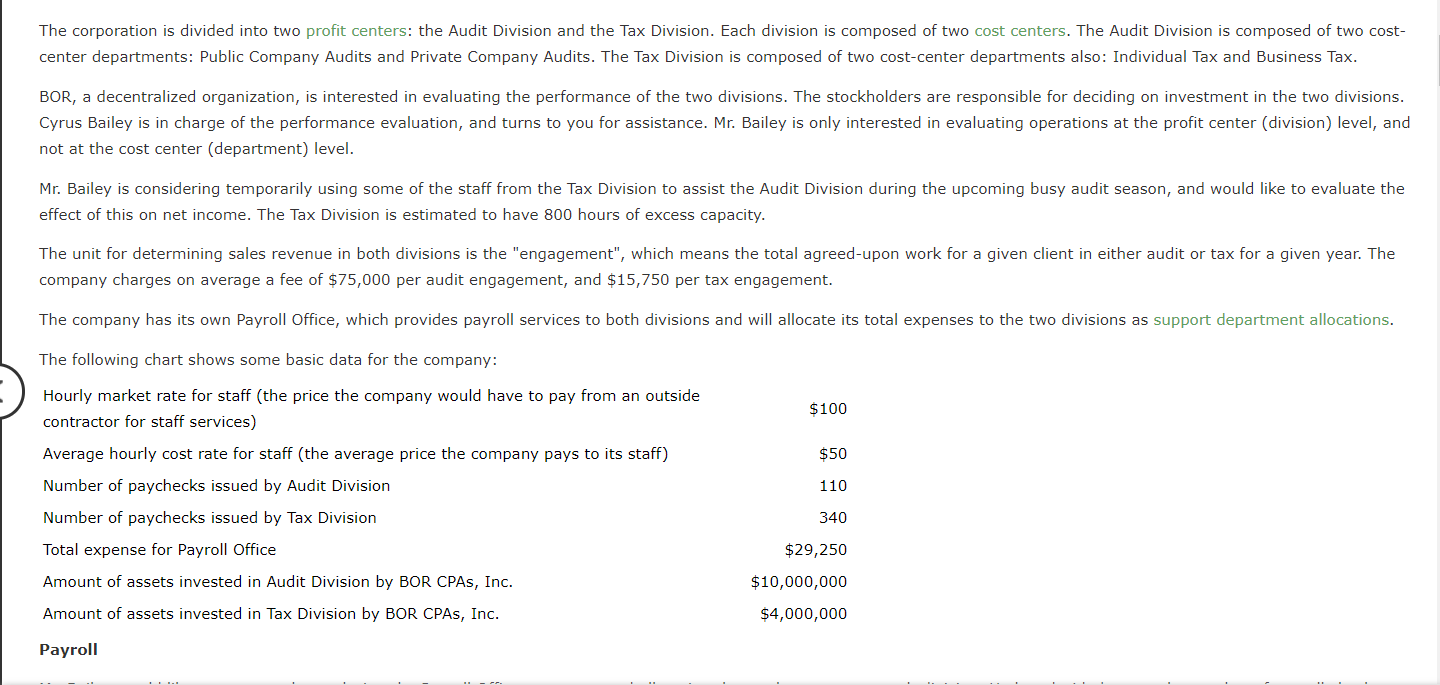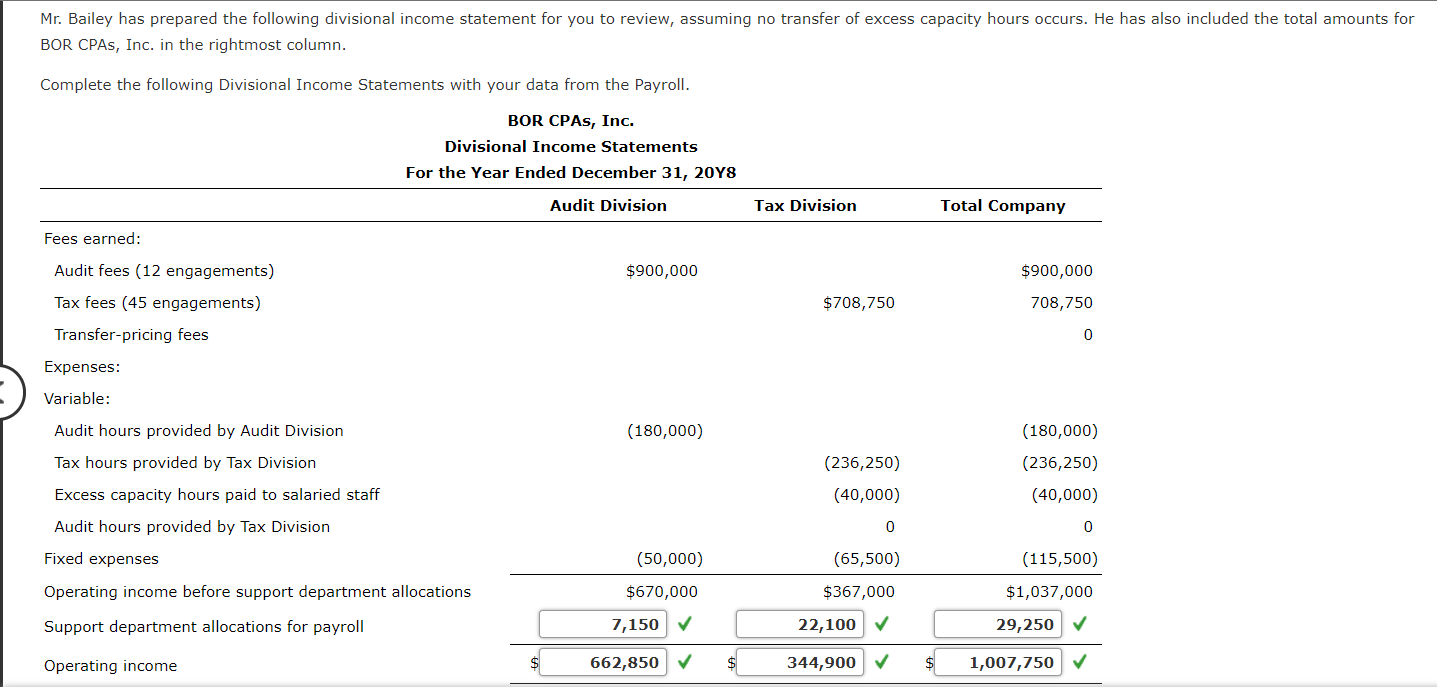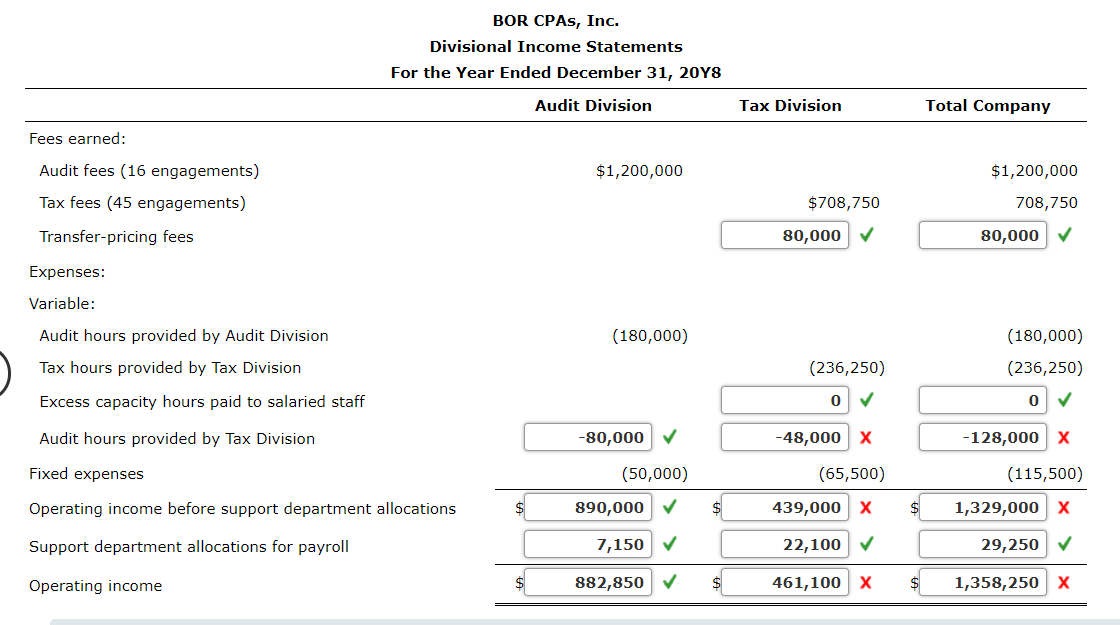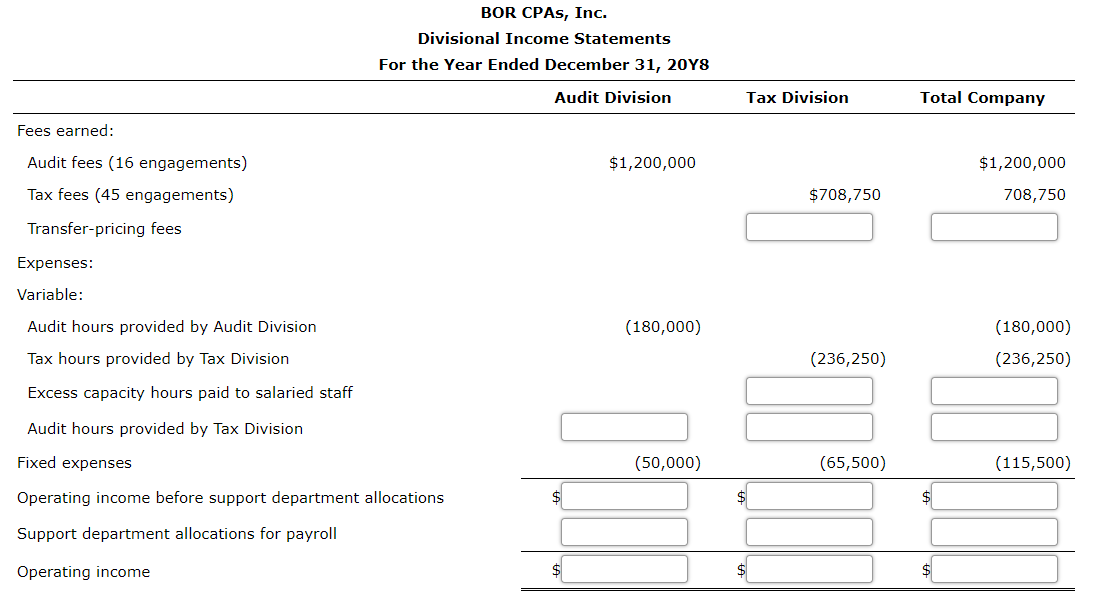







 Please answer the ones I got wrong in the charts and the ones I do not have filled out. The other screenshots are just information you may need to help solve the problem.
Please answer the ones I got wrong in the charts and the ones I do not have filled out. The other screenshots are just information you may need to help solve the problem.
The corporation is divided into two profit centers: the Audit Division and the Tax Division. Each division is composed of two cost centers. The Audit Division is composed of two cost- center departments: Public Company Audits and Private Company Audits. The Tax Division is composed of two cost-center departments also: Individual Tax and Business Tax. BOR, a decentralized organization, is interested in evaluating the performance of the two divisions. The stockholders are responsible for deciding on investment in the two divisions. Cyrus Bailey is in charge of the performance evaluation, and turns to you for assistance. Mr. Bailey is only interested in evaluating operations at the profit center (division) level, and not at the cost center (department) level. Mr. Bailey is considering temporarily using some of the staff from the Tax Division to assist the Audit Division during the upcoming busy audit season, and would like to evaluate the effect of this on net income. The Tax Division is estimated to have 800 hours of excess capacity. The unit for determining sales revenue in both divisions is the "engagement", which means the total agreed-upon work for a given client in either audit or tax for a given year. The company charges on average a fee of $75,000 per audit engagement, and $15,750 per tax engagement. The company has its own Payroll Office, which provides payroll services to both divisions and will allocate its total expenses to the two divisions as support department allocations. $100 $50 The following chart shows some basic data for the company: Hourly market rate for staff (the price the company would have to pay from an outside contractor for staff services) Average hourly cost rate for staff (the average price the company pays to its staff) Number of paychecks issued by Audit Division Number of paychecks issued by Tax Division Total expense for Payroll Office Amount of assets invested in Audit Division by BOR CPAs, Inc. Amount of assets invested in Tax Division by BOR CPAs, Inc. 110 340 $29,250 $10,000,000 $4,000,000 Payroll Payroll Mr. Bailey would like you to start by analyzing the Payroll Office expenses, and allocating the total expenses to each division. He has decided to use the number of payroll checks as the activity base for the allocation. Fill in the following blanks, allocating the total expense for the Payroll Office to each of the two divisions. Payroll Charge Rate $ 65 per payroll check Support Department Allocations Division Audit Division $ 7,150 Tax Division 22,100 Feedback Check My Work Review the computation of support department allocations based on an activity base. Mr. Bailey has prepared the following divisional income statement for you to review, assuming no transfer of excess capacity hours occurs. He has also included the total amounts for BOR CPAs, Inc. in the rightmost column. Complete the following Divisional Income Statements with your data from the Payroll. BOR CPAs, Inc. Divisional Income Statements For the Year Ended December 31, 2018 Audit Division Tax Division Total Company Fees earned: $900,000 $900,000 $708,750 708,750 Audit fees (12 engagements) Tax fees (45 engagements) Transfer-pricing fees Expenses: Variable: 0 (180,000) Audit hours provided by Audit Division Tax hours provided by Tax Division Excess capacity hours paid to salaried staff Audit hours provided by Tax Division (236,250) (40,000) (180,000) (236,250) (40,000) 0 0 Fixed expenses (50,000) (65,500) (115,500) $670,000 $367,000 $1,037,000 Operating income before support department allocations Support department allocations for payroll 7,150 22,100 29,250 Operating income 662,850 $ 344,900 $ 1,007,750 Market Transfer Price Mr. Bailey asks that you prepare Divisional Income Statements showing what 20Y8 results would have been had the Audit Division purchased all the excess capacity of the Tax Division, using a market transfer price. The divisional managers tell you that, with the excess capacity of the Tax Division of 800 hours, the Audit Division can perform 4 more audits during the year, and the Tax Division would charge the Audit Division the market rate of $100 per hour for the additional hours required, selling all its excess capacity to the Audit Division. The Tax Division would still be responsible for paying the salaries of their employees. Complete the following Divisional Income Statements. If there is no amount or an amount is zero, enter "o". BOR CPAs, Inc. Divisional Income Statements For the Year Ended December 31, 2048 Audit Division Tax Division Total Company Fees earned: $1,200,000 $1,200,000 Audit fees (16 engagements) Tax fees (45 engagements) $708,750 708,750 Transfer pricing fees 80,000 80,000 Expenses: Variable: (180,000) Audit hours provided by Audit Division Tax hours provided by Tax Division Excess capacity hours paid to salaried staff (180,000) (236,250) (236,250) 0 Audit hours provided by Tax Division -80,000 -48,000 X -128,000 X Fixed expenses (50,000) (65,500) (115,500) 1,329,000 X Operating income before support department allocations $ 890,000 439,000 X $ Support department allocations for payroll 7,150 22,100 29,250 Operating income $ 882,850 $ 461,100 X $ 1,358,250 X Negotiated Transfer Price Mr. Bailey asks that you prepare Divisional Income Statements showing what 2048 results would have been had the Audit Division purchased all the excess capacity of the Tax Division, using a negotiated transfer price. The divisional managers tell you that, with the excess capacity of the Tax Division of 800 hours, the Audit Division can perform 4 more audits during the year, and the Audit Division would agree to a negotiated rate of $90 per hour to be paid to the Tax Division for the additional hours required, with the Tax Division selling all its excess capacity to the Audit Division. The Tax Division would still be responsible for paying the salaries of their employees. Complete the following Divisional Income Statements. If there is no amount or an amount is zero, enter "o". BOR CPAs, Inc. Divisional Income Statements For the Year Ended December 31, 2018 Audit Division Tax Division Total Company Fees earned: $1,200,000 $1,200,000 Audit fees (16 engagements) Tax fees (45 engagements) $708,750 708,750 Transfer-pricing fees Expenses: Variable: (180,000) Audit hours provided by Audit Division Tax hours provided by Tax Division Excess capacity hours paid to salaried staff (180,000) (236,250) (236,250) Audit hours provided by Tax Division Fixed expenses (50,000) (65,500) (115,500) Operating income before support department allocations Support department allocations for payroll Operating income Cost Transfer Price Mr. Bailey asks that you prepare Divisional Income Statements showing what 2048 results would have been had the Audit Division purchased all the excess capacity of the Tax Division, using a cost transfer price. The divisional managers tell you that, with the excess capacity of the Tax Division of 800 hours, the Audit Division can perform 4 more audits during the year, and the Audit Division would pay the Tax Division's internal hourly rate of $50 per hour for the additional hours required, with the Tax Division selling all its excess capacity to the Audit Division. The Tax Division would still be responsible for paying the salaries of their employees. Complete the following Divisional Income Statements. If there is no amount or an amount is zero, enter "0". BOR CPAs, Inc. Divisional Income Statements For the Year Ended December 31, 2018 Audit Division Tax Division Total Company Fees earned: $1,200,000 Audit fees (16 engagements) Tax fees (45 engagements) Transfer-pricing fees $1,200,000 708,750 $708,750 Expenses: Variable: Audit hours provided by Audit Division (180,000) (180,000) (236,250) Tax hours provided by Tax Division (236,250) Excess capacity hours paid to salaried staff Audit hours provided by Tax Division Fixed expenses (50,000) (65,500) (115,500) $ Operating income before support department allocations Support department allocations for payroll Operating income $ The corporation is divided into two profit centers: the Audit Division and the Tax Division. Each division is composed of two cost centers. The Audit Division is composed of two cost- center departments: Public Company Audits and Private Company Audits. The Tax Division is composed of two cost-center departments also: Individual Tax and Business Tax. BOR, a decentralized organization, is interested in evaluating the performance of the two divisions. The stockholders are responsible for deciding on investment in the two divisions. Cyrus Bailey is in charge of the performance evaluation, and turns to you for assistance. Mr. Bailey is only interested in evaluating operations at the profit center (division) level, and not at the cost center (department) level. Mr. Bailey is considering temporarily using some of the staff from the Tax Division to assist the Audit Division during the upcoming busy audit season, and would like to evaluate the effect of this on net income. The Tax Division is estimated to have 800 hours of excess capacity. The unit for determining sales revenue in both divisions is the "engagement", which means the total agreed-upon work for a given client in either audit or tax for a given year. The company charges on average a fee of $75,000 per audit engagement, and $15,750 per tax engagement. The company has its own Payroll Office, which provides payroll services to both divisions and will allocate its total expenses to the two divisions as support department allocations. $100 $50 The following chart shows some basic data for the company: Hourly market rate for staff (the price the company would have to pay from an outside contractor for staff services) Average hourly cost rate for staff (the average price the company pays to its staff) Number of paychecks issued by Audit Division Number of paychecks issued by Tax Division Total expense for Payroll Office Amount of assets invested in Audit Division by BOR CPAs, Inc. Amount of assets invested in Tax Division by BOR CPAs, Inc. 110 340 $29,250 $10,000,000 $4,000,000 Payroll Payroll Mr. Bailey would like you to start by analyzing the Payroll Office expenses, and allocating the total expenses to each division. He has decided to use the number of payroll checks as the activity base for the allocation. Fill in the following blanks, allocating the total expense for the Payroll Office to each of the two divisions. Payroll Charge Rate $ 65 per payroll check Support Department Allocations Division Audit Division $ 7,150 Tax Division 22,100 Feedback Check My Work Review the computation of support department allocations based on an activity base. Mr. Bailey has prepared the following divisional income statement for you to review, assuming no transfer of excess capacity hours occurs. He has also included the total amounts for BOR CPAs, Inc. in the rightmost column. Complete the following Divisional Income Statements with your data from the Payroll. BOR CPAs, Inc. Divisional Income Statements For the Year Ended December 31, 2018 Audit Division Tax Division Total Company Fees earned: $900,000 $900,000 $708,750 708,750 Audit fees (12 engagements) Tax fees (45 engagements) Transfer-pricing fees Expenses: Variable: 0 (180,000) Audit hours provided by Audit Division Tax hours provided by Tax Division Excess capacity hours paid to salaried staff Audit hours provided by Tax Division (236,250) (40,000) (180,000) (236,250) (40,000) 0 0 Fixed expenses (50,000) (65,500) (115,500) $670,000 $367,000 $1,037,000 Operating income before support department allocations Support department allocations for payroll 7,150 22,100 29,250 Operating income 662,850 $ 344,900 $ 1,007,750 Market Transfer Price Mr. Bailey asks that you prepare Divisional Income Statements showing what 20Y8 results would have been had the Audit Division purchased all the excess capacity of the Tax Division, using a market transfer price. The divisional managers tell you that, with the excess capacity of the Tax Division of 800 hours, the Audit Division can perform 4 more audits during the year, and the Tax Division would charge the Audit Division the market rate of $100 per hour for the additional hours required, selling all its excess capacity to the Audit Division. The Tax Division would still be responsible for paying the salaries of their employees. Complete the following Divisional Income Statements. If there is no amount or an amount is zero, enter "o". BOR CPAs, Inc. Divisional Income Statements For the Year Ended December 31, 2048 Audit Division Tax Division Total Company Fees earned: $1,200,000 $1,200,000 Audit fees (16 engagements) Tax fees (45 engagements) $708,750 708,750 Transfer pricing fees 80,000 80,000 Expenses: Variable: (180,000) Audit hours provided by Audit Division Tax hours provided by Tax Division Excess capacity hours paid to salaried staff (180,000) (236,250) (236,250) 0 Audit hours provided by Tax Division -80,000 -48,000 X -128,000 X Fixed expenses (50,000) (65,500) (115,500) 1,329,000 X Operating income before support department allocations $ 890,000 439,000 X $ Support department allocations for payroll 7,150 22,100 29,250 Operating income $ 882,850 $ 461,100 X $ 1,358,250 X Negotiated Transfer Price Mr. Bailey asks that you prepare Divisional Income Statements showing what 2048 results would have been had the Audit Division purchased all the excess capacity of the Tax Division, using a negotiated transfer price. The divisional managers tell you that, with the excess capacity of the Tax Division of 800 hours, the Audit Division can perform 4 more audits during the year, and the Audit Division would agree to a negotiated rate of $90 per hour to be paid to the Tax Division for the additional hours required, with the Tax Division selling all its excess capacity to the Audit Division. The Tax Division would still be responsible for paying the salaries of their employees. Complete the following Divisional Income Statements. If there is no amount or an amount is zero, enter "o". BOR CPAs, Inc. Divisional Income Statements For the Year Ended December 31, 2018 Audit Division Tax Division Total Company Fees earned: $1,200,000 $1,200,000 Audit fees (16 engagements) Tax fees (45 engagements) $708,750 708,750 Transfer-pricing fees Expenses: Variable: (180,000) Audit hours provided by Audit Division Tax hours provided by Tax Division Excess capacity hours paid to salaried staff (180,000) (236,250) (236,250) Audit hours provided by Tax Division Fixed expenses (50,000) (65,500) (115,500) Operating income before support department allocations Support department allocations for payroll Operating income Cost Transfer Price Mr. Bailey asks that you prepare Divisional Income Statements showing what 2048 results would have been had the Audit Division purchased all the excess capacity of the Tax Division, using a cost transfer price. The divisional managers tell you that, with the excess capacity of the Tax Division of 800 hours, the Audit Division can perform 4 more audits during the year, and the Audit Division would pay the Tax Division's internal hourly rate of $50 per hour for the additional hours required, with the Tax Division selling all its excess capacity to the Audit Division. The Tax Division would still be responsible for paying the salaries of their employees. Complete the following Divisional Income Statements. If there is no amount or an amount is zero, enter "0". BOR CPAs, Inc. Divisional Income Statements For the Year Ended December 31, 2018 Audit Division Tax Division Total Company Fees earned: $1,200,000 Audit fees (16 engagements) Tax fees (45 engagements) Transfer-pricing fees $1,200,000 708,750 $708,750 Expenses: Variable: Audit hours provided by Audit Division (180,000) (180,000) (236,250) Tax hours provided by Tax Division (236,250) Excess capacity hours paid to salaried staff Audit hours provided by Tax Division Fixed expenses (50,000) (65,500) (115,500) $ Operating income before support department allocations Support department allocations for payroll Operating income $








 Please answer the ones I got wrong in the charts and the ones I do not have filled out. The other screenshots are just information you may need to help solve the problem.
Please answer the ones I got wrong in the charts and the ones I do not have filled out. The other screenshots are just information you may need to help solve the problem.





